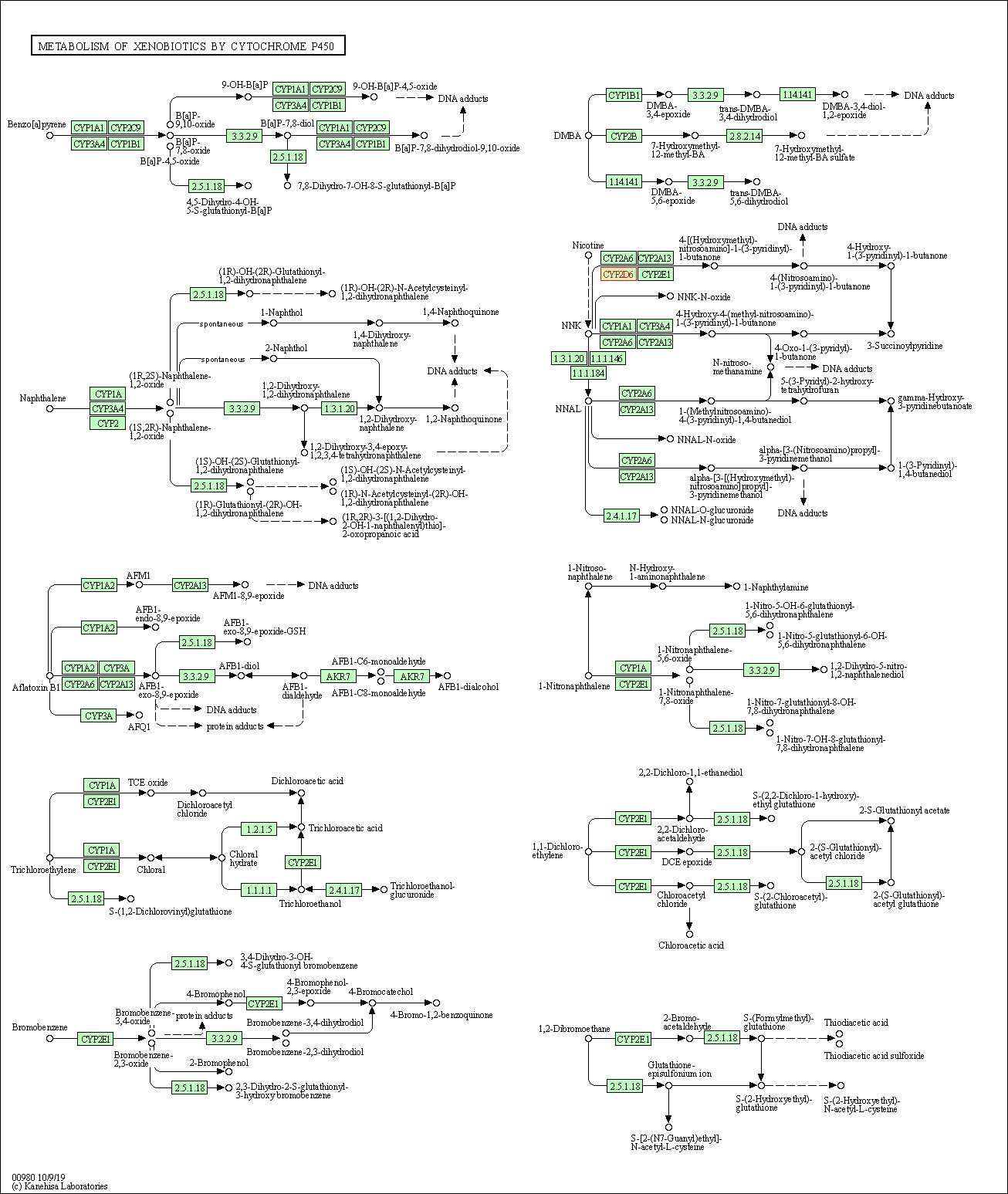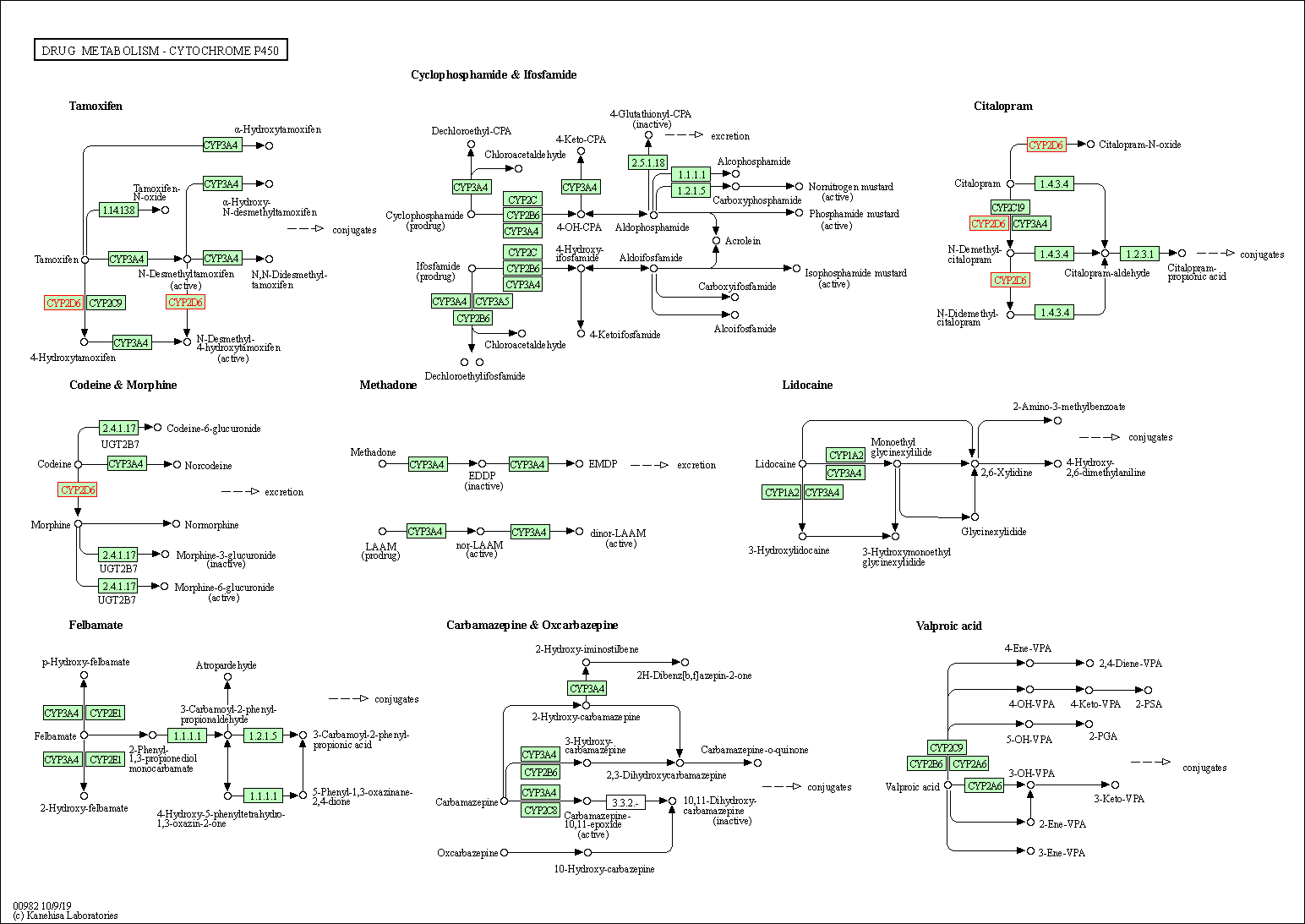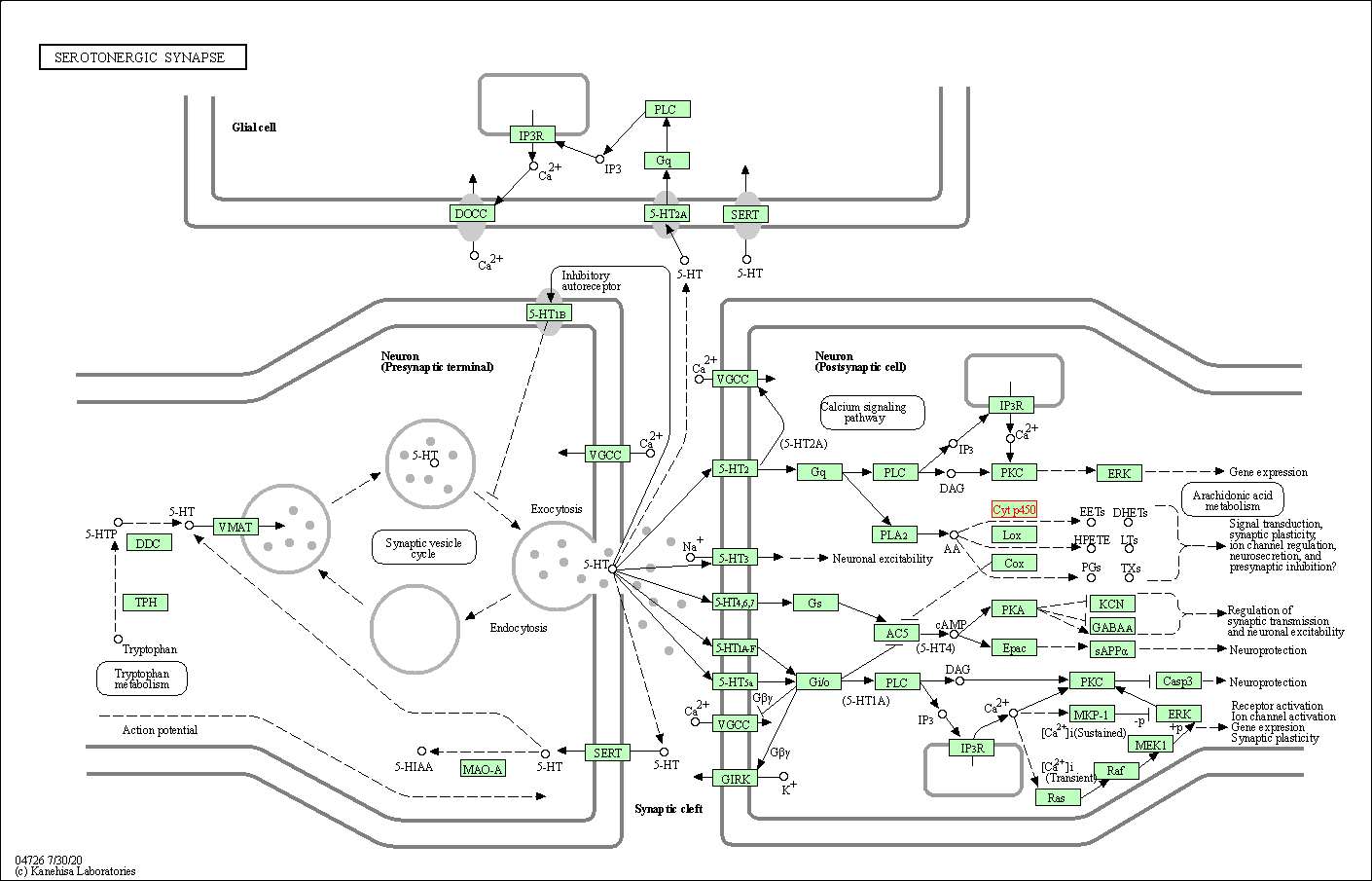Target Information
| Target General Information | Top | |||||
|---|---|---|---|---|---|---|
| Target ID |
T57392
(Former ID: TTDS00475)
|
|||||
| Target Name |
Debrisoquine 4-hydroxylase (CYP2D6)
|
|||||
| Synonyms |
P450-DB1; Cytochrome P450-DB1; Cytochrome P450 2D6; CYPIID6; CYP2DL1
Click to Show/Hide
|
|||||
| Gene Name |
CYP2D6
|
|||||
| Target Type |
Successful target
|
[1] | ||||
| Disease | [+] 1 Target-related Diseases | + | ||||
| 1 | Insomnia [ICD-11: 7A00-7A0Z] | |||||
| Function |
It is involved in the metabolism of drugs such as antiarrhythmics, adrenoceptor antagonists, and tricyclic antidepressants. Responsible for the metabolism of many drugs and environmental chemicals that it oxidizes.
Click to Show/Hide
|
|||||
| BioChemical Class |
Paired donor oxygen oxidoreductase
|
|||||
| UniProt ID | ||||||
| EC Number |
EC 1.14.14.-
|
|||||
| Sequence |
MGLEALVPLAVIVAIFLLLVDLMHRRQRWAARYPPGPLPLPGLGNLLHVDFQNTPYCFDQ
LRRRFGDVFSLQLAWTPVVVLNGLAAVREALVTHGEDTADRPPVPITQILGFGPRSQGVF LARYGPAWREQRRFSVSTLRNLGLGKKSLEQWVTEEAACLCAAFANHSGRPFRPNGLLDK AVSNVIASLTCGRRFEYDDPRFLRLLDLAQEGLKEESGFLREVLNAVPVLLHIPALAGKV LRFQKAFLTQLDELLTEHRMTWDPAQPPRDLTEAFLAEMEKAKGNPESSFNDENLRIVVA DLFSAGMVTTSTTLAWGLLLMILHPDVQRRVQQEIDDVIGQVRRPEMGDQAHMPYTTAVI HEVQRFGDIVPLGVTHMTSRDIEVQGFRIPKGTTLITNLSSVLKDEAVWEKPFRFHPEHF LDAQGHFVKPEAFLPFSAGRRACLGEPLARMELFLFFTSLLQHFSFSVPTGQPRPSHHGV FAFLVSPSPYELCAVPR Click to Show/Hide
|
|||||
| 3D Structure | Click to Show 3D Structure of This Target | PDB | ||||
| ADReCS ID | BADD_A00232 ; BADD_A00323 ; BADD_A00378 ; BADD_A01205 ; BADD_A01334 ; BADD_A01338 ; BADD_A01965 ; BADD_A01976 ; BADD_A02053 ; BADD_A02189 ; BADD_A02978 ; BADD_A03487 ; BADD_A03957 ; BADD_A04155 ; BADD_A04234 ; BADD_A04424 ; BADD_A05280 ; BADD_A05962 ; BADD_A06157 ; BADD_A06627 | |||||
| HIT2.0 ID | T11ZYR | |||||
| Drugs and Modes of Action | Top | |||||
|---|---|---|---|---|---|---|
| Clinical Trial Drug(s) | [+] 1 Clinical Trial Drugs | + | ||||
| 1 | ISOQUINE | Drug Info | Phase 1 | Malaria | [4] | |
| Mode of Action | [+] 1 Modes of Action | + | ||||
| Inhibitor | [+] 39 Inhibitor drugs | + | ||||
| 1 | ISOQUINE | Drug Info | [5] | |||
| 2 | (2-hydroxy-3-phenoxypropyl)(propan-2-yl)amine | Drug Info | [6] | |||
| 3 | (5-(pyridin-3-yl)furan-2-yl)methanamine | Drug Info | [7] | |||
| 4 | 1,5-bis(4-hydroxyphenyl)penta-1,4-dien-3-one | Drug Info | [8] | |||
| 5 | 1-(3,4-DICHLOROPHENYL)-6-(METHOXYMETHYL)-3-AZABICYCLO[4.1.0]HEPTANE (ENANTIOMERIC MIX) | Drug Info | [9] | |||
| 6 | 1-(4-Butoxy-phenyl)-1H-imidazole | Drug Info | [10] | |||
| 7 | 1-(METHOXYMETHYL)-6-(NAPHTHALEN-2-YL)-3-AZABICYCLO[4.1.0]HEPTANE (ENANTIOMERIC MIX) | Drug Info | [9] | |||
| 8 | 1H-1,2,3-benzotriazol-1-amine | Drug Info | [11] | |||
| 9 | 2-(2-(4-tert-Butylphenylthio)ethyl)-1H-imidazole | Drug Info | [12] | |||
| 10 | 2-(4-Imidazol-1-yl-phenoxymethyl)-pyridine | Drug Info | [10] | |||
| 11 | 2-Fluoro-4-[5-(3-hydroxyphenyl)-2-thienyl]phenol | Drug Info | [13] | |||
| 12 | 2-Hexyloxy-5-imidazol-1-yl-pyridine | Drug Info | [10] | |||
| 13 | 3-(6-Methoxynaphthalen-2-yl)pyridin-4-amine | Drug Info | [14] | |||
| 14 | 3-[3-(4-Imidazol-1-yl-phenoxy)-propyl]-pyridine | Drug Info | [10] | |||
| 15 | 4-(3-Pent-1-ynyl-benzyl)-1H-imidazole | Drug Info | [15] | |||
| 16 | 4-(3-Phenylethynyl-benzyl)-1H-imidazole | Drug Info | [15] | |||
| 17 | 4-(Spiro[chromene-2,4'-piperidine]-4-yl)benzamide | Drug Info | [16] | |||
| 18 | 4-methylaminomethyl-7-methoxycoumarin | Drug Info | [17] | |||
| 19 | 4-[2-(4-Imidazol-1-yl-phenoxy)-ethyl]-morpholine | Drug Info | [10] | |||
| 20 | 4-[3-(4-Imidazol-1-yl-phenoxy)-propyl]-pyridine | Drug Info | [10] | |||
| 21 | 4-[5-(3-Hydroxyphenyl)-3-thienyl]-2-methylphenol | Drug Info | [13] | |||
| 22 | 6-(3,4-DICHLOROPHENYL)-1-[1-(METHYLOXY)-3-BUTEN-1-YL]-3-AZABICYCLO[4.1.0]HEPTANE (DIASTEREOMERIC MIX) | Drug Info | [9] | |||
| 23 | Bis-(5-pyridin-3-yl-thiophen-2-ylmethyl)-amine | Drug Info | [18] | |||
| 24 | BMS-694153 | Drug Info | [19] | |||
| 25 | BS 7581 | Drug Info | [20] | |||
| 26 | BS 7840 | Drug Info | [20] | |||
| 27 | Desethyl isoquine | Drug Info | [5] | |||
| 28 | DIHYDROCUBEBIN | Drug Info | [21] | |||
| 29 | GB-12819 | Drug Info | [20] | |||
| 30 | GBR-12289 | Drug Info | [20] | |||
| 31 | GNF-PF-4292 | Drug Info | [22] | |||
| 32 | GNF-PF-5411 | Drug Info | [22] | |||
| 33 | Go-Y022 | Drug Info | [8] | |||
| 34 | ICI-199441 | Drug Info | [23] | |||
| 35 | Kaempferol-3-O-methyl ether | Drug Info | [24] | |||
| 36 | Methyl-(5-pyridin-3-yl-thiophen-2-yl)-amine | Drug Info | [18] | |||
| 37 | ML-3163 | Drug Info | [25] | |||
| 38 | Prodipine | Drug Info | [22] | |||
| 39 | SB-210313 | Drug Info | [26] | |||
| Cell-based Target Expression Variations | Top | |||||
|---|---|---|---|---|---|---|
| Cell-based Target Expression Variations | ||||||
| Drug Binding Sites of Target | Top | |||||
|---|---|---|---|---|---|---|
| Ligand Name: Quinine | Ligand Info | |||||
| Structure Description | Human Cytochrome P450 2D6 Quinine Complex | PDB:4WNV | ||||
| Method | X-ray diffraction | Resolution | 2.35 Å | Mutation | No | [27] |
| PDB Sequence |
GKLPPGPLPL
40 PGLGNLLFQN53 TPYCFDQLRR63 RFGDVFSLQL73 AWTPVVVLNG83 LAAVREALVT 93 HGEDTADRPP103 VPITQILGFG113 PRSQGVFLAR123 YGPAWREQRR133 FSVSTLRNLG 143 LGKKSLEQWV153 TEEAACLCAA163 FANHSGRPFR173 PNGLLDKAVS183 NVIASLTCGR 193 RFEYDDPRFL203 RLLDLAQEGL213 KEESGFLREV223 LNAVPVLLHI233 PALAGKVLRF 243 QKAFLTQLDE253 LLTEHRMTWD263 PAQPPRDLTE273 AFLAEMEKAK283 GNPESSFNDE 293 NLRIVVADLF303 SAGMVTTSTT313 LAWGLLLMIL323 HPDVQRRVQQ333 EIDDVIGQVR 343 RPEMGDQAHM353 PYTTAVIHEV363 QRFGDIVPLG373 VTHMTSRDIE383 VQGFRIPKGT 393 TLITNLSSVL403 KDEAVWEKPF413 RFHPEHFLDA423 QGHFVKPEAF433 LPFSAGRRAC 443 LGEPLARMEL453 FLFFTSLLQH463 FSFSVPTGQP473 RPSHHGVFAF483 LVSPSPYELC 493 AVPR
|
|||||
|
|
||||||
| Ligand Name: Prinomastat | Ligand Info | |||||
| Structure Description | V308E mutant of cytochrome P450 2D6 complexed with prinomastat | PDB:6CSD | ||||
| Method | X-ray diffraction | Resolution | 2.39 Å | Mutation | Yes | [28] |
| PDB Sequence |
KLPPGPNLLH
48 VDFQNTPYCF58 DQLRRRFGDV68 FSLQLAWTPV78 VVLNGLAAVR88 EALVTHGEDT 98 ADRPPVPITQ108 ILGFGPRSQG118 VFLARYGPAW128 REQRRFSVST138 LRNLGLGKKS 148 LEQWVTEEAA158 CLCAAFANHS168 GRPFRPNGLL178 DKAVSNVIAS188 LTCGRRFEYD 198 DPRFLRLLDL208 AQEGLKEESG218 FLREVLNAVP228 VLLHIPALAG238 KVLRFQKAFL 248 TQLDELLTEH258 RMTWDPAQPP268 RDLTEAFLAE278 MEKAKGNPES288 SFNDENLRIV 298 VADLFSAGME308 TTSTTLAWGL318 LLMILHPDVQ328 RRVQQEIDDV338 IGQVRRPEMG 348 DQAHMPYTTA358 VIHEVQRFGD368 IVPLGVTHMT378 SRDIEVQGFR388 IPKGTTLITN 398 LSSVLKDEAV408 WEKPFRFHPE418 HFLDAQGHFV428 KPEAFLPFSA438 GRRACLGEPL 448 ARMELFLFFT458 SLLQHFSFSV468 PTGQPRPSHH478 GVFAFLVSPS488 PYELCAVPRH 498 HH
|
|||||
|
|
LEU110
4.031
PHE112
4.015
PHE120
3.425
LEU121
3.678
ALA209
4.917
GLY212
3.520
LEU213
3.767
GLU216
3.435
GLN244
3.483
PHE247
4.725
ILE297
3.811
|
|||||
| Click to View More Binding Site Information of This Target and Ligand Pair | ||||||
| Click to View More Binding Site Information of This Target with Different Ligands | ||||||
| Different Human System Profiles of Target | Top |
|---|---|
|
Human Similarity Proteins
of target is determined by comparing the sequence similarity of all human proteins with the target based on BLAST. The similarity proteins for a target are defined as the proteins with E-value < 0.005 and outside the protein families of the target.
A target that has fewer human similarity proteins outside its family is commonly regarded to possess a greater capacity to avoid undesired interactions and thus increase the possibility of finding successful drugs
(Brief Bioinform, 21: 649-662, 2020).
Human Tissue Distribution
of target is determined from a proteomics study that quantified more than 12,000 genes across 32 normal human tissues. Tissue Specificity (TS) score was used to define the enrichment of target across tissues.
The distribution of targets among different tissues or organs need to be taken into consideration when assessing the target druggability, as it is generally accepted that the wider the target distribution, the greater the concern over potential adverse effects
(Nat Rev Drug Discov, 20: 64-81, 2021).
Human Pathway Affiliation
of target is determined by the life-essential pathways provided on KEGG database. The target-affiliated pathways were defined based on the following two criteria (a) the pathways of the studied target should be life-essential for both healthy individuals and patients, and (b) the studied target should occupy an upstream position in the pathways and therefore had the ability to regulate biological function.
Targets involved in a fewer pathways have greater likelihood to be successfully developed, while those associated with more human pathways increase the chance of undesirable interferences with other human processes
(Pharmacol Rev, 58: 259-279, 2006).
Biological Network Descriptors
of target is determined based on a human protein-protein interactions (PPI) network consisting of 9,309 proteins and 52,713 PPIs, which were with a high confidence score of ≥ 0.95 collected from STRING database.
The network properties of targets based on protein-protein interactions (PPIs) have been widely adopted for the assessment of target’s druggability. Proteins with high node degree tend to have a high impact on network function through multiple interactions, while proteins with high betweenness centrality are regarded to be central for communication in interaction networks and regulate the flow of signaling information
(Front Pharmacol, 9, 1245, 2018;
Curr Opin Struct Biol. 44:134-142, 2017).
Human Similarity Proteins
Human Tissue Distribution
Human Pathway Affiliation
Biological Network Descriptors
|
|
|
There is no similarity protein (E value < 0.005) for this target
|
|
Note:
If a protein has TS (tissue specficity) scores at least in one tissue >= 2.5, this protein is called tissue-enriched (including tissue-enriched-but-not-specific and tissue-specific). In the plots, the vertical lines are at thresholds 2.5 and 4.
|
| KEGG Pathway | Pathway ID | Affiliated Target | Pathway Map |
|---|---|---|---|
| Metabolism of xenobiotics by cytochrome P450 | hsa00980 | Affiliated Target |

|
| Class: Metabolism => Xenobiotics biodegradation and metabolism | Pathway Hierarchy | ||
| Drug metabolism - cytochrome P450 | hsa00982 | Affiliated Target |

|
| Class: Metabolism => Xenobiotics biodegradation and metabolism | Pathway Hierarchy | ||
| Serotonergic synapse | hsa04726 | Affiliated Target |

|
| Class: Organismal Systems => Nervous system | Pathway Hierarchy | ||
| Degree | 2 | Degree centrality | 2.15E-04 | Betweenness centrality | 1.94E-05 |
|---|---|---|---|---|---|
| Closeness centrality | 1.62E-01 | Radiality | 1.24E+01 | Clustering coefficient | 0.00E+00 |
| Neighborhood connectivity | 1.30E+01 | Topological coefficient | 5.00E-01 | Eccentricity | 12 |
| Download | Click to Download the Full PPI Network of This Target | ||||
| Chemical Structure based Activity Landscape of Target | Top |
|---|---|
| Drug Property Profile of Target | Top | |
|---|---|---|
| (1) Molecular Weight (mw) based Drug Clustering | (2) Octanol/Water Partition Coefficient (xlogp) based Drug Clustering | |
|
|
||
| (3) Hydrogen Bond Donor Count (hbonddonor) based Drug Clustering | (4) Hydrogen Bond Acceptor Count (hbondacc) based Drug Clustering | |
|
|
||
| (5) Rotatable Bond Count (rotbonds) based Drug Clustering | (6) Topological Polar Surface Area (polararea) based Drug Clustering | |
|
|
||
| "RO5" indicates the cutoff set by lipinski's rule of five; "D123AB" colored in GREEN denotes the no violation of any cutoff in lipinski's rule of five; "D123AB" colored in PURPLE refers to the violation of only one cutoff in lipinski's rule of five; "D123AB" colored in BLACK represents the violation of more than one cutoffs in lipinski's rule of five | ||
| Target Poor or Non Binders | Top | |||||
|---|---|---|---|---|---|---|
| Target Poor or Non Binders | ||||||
| Target Regulators | Top | |||||
|---|---|---|---|---|---|---|
| Target-regulating Transcription Factors | ||||||
| Target Affiliated Biological Pathways | Top | |||||
|---|---|---|---|---|---|---|
| KEGG Pathway | [+] 3 KEGG Pathways | + | ||||
| 1 | Metabolism of xenobiotics by cytochrome P450 | |||||
| 2 | Drug metabolism - cytochrome P450 | |||||
| 3 | Serotonergic synapse | |||||
| Reactome | [+] 1 Reactome Pathways | + | ||||
| 1 | Xenobiotics | |||||
| WikiPathways | [+] 7 WikiPathways | + | ||||
| 1 | Metapathway biotransformation | |||||
| 2 | Tamoxifen metabolism | |||||
| 3 | Oxidation by Cytochrome P450 | |||||
| 4 | Vitamin D Receptor Pathway | |||||
| 5 | Aripiprazole Metabolic Pathway | |||||
| 6 | Fatty Acid Omega Oxidation | |||||
| 7 | Codeine and Morphine Metabolism | |||||
| Target-Related Models and Studies | Top | |||||
|---|---|---|---|---|---|---|
| Target Validation | ||||||
| References | Top | |||||
|---|---|---|---|---|---|---|
| REF 1 | A study of the effects of large doses of glutethimide that were used for self-poisoning during pregnancy on human fetuses. Toxicol Ind Health. 2008 Feb-Mar;24(1-2):69-78. | |||||
| REF 2 | URL: http://www.guidetopharmacology.org Nucleic Acids Res. 2015 Oct 12. pii: gkv1037. The IUPHAR/BPS Guide to PHARMACOLOGY in 2016: towards curated quantitative interactions between 1300 protein targets and 6000 ligands. (Ligand id: 7192). | |||||
| REF 3 | A comparison of the efficacy of aromatase inhibitors in second-line treatment of metastatic breast cancer. Am J Clin Oncol. 2003 Aug;26(4):S9-16. | |||||
| REF 4 | Antimalarial activity of isoquine against Kenyan Plasmodium falciparum clinical isolates and association with polymorphisms in pfcrt and pfmdr1 genes. J Antimicrob Chemother. 2013 Apr;68(4):786-8. | |||||
| REF 5 | Candidate selection and preclinical evaluation of N-tert-butyl isoquine (GSK369796), an affordable and effective 4-aminoquinoline antimalarial for ... J Med Chem. 2009 Mar 12;52(5):1408-15. | |||||
| REF 6 | A 3D-QSAR model for CYP2D6 inhibition in the aryloxypropanolamine series. Bioorg Med Chem Lett. 2005 Sep 1;15(17):3816-20. | |||||
| REF 7 | Synthetic inhibitors of cytochrome P-450 2A6: inhibitory activity, difference spectra, mechanism of inhibition, and protein cocrystallization. J Med Chem. 2006 Nov 30;49(24):6987-7001. | |||||
| REF 8 | Structure-activity relationships for the inhibition of recombinant human cytochromes P450 by curcumin analogues. Eur J Med Chem. 2008 Aug;43(8):1621-31. | |||||
| REF 9 | 6-(3,4-dichlorophenyl)-1-[(methyloxy)methyl]-3-azabicyclo[4.1.0]heptane: a new potent and selective triple reuptake inhibitor. J Med Chem. 2010 Jul 8;53(13):4989-5001. | |||||
| REF 10 | Imidazole derivatives as new potent and selective 20-HETE synthase inhibitors. Bioorg Med Chem Lett. 2004 Jan 19;14(2):333-6. | |||||
| REF 11 | Discovery of a N'-hydroxyphenylformamidine derivative HET0016 as a potent and selective 20-HETE synthase inhibitor. Bioorg Med Chem Lett. 2001 Dec 3;11(23):2993-5. | |||||
| REF 12 | Role of hydrophobic substituents on the terminal nitrogen of histamine in receptor binding and agonist activity: development of an orally active hi... J Med Chem. 2010 May 13;53(9):3840-4. | |||||
| REF 13 | New insights into the SAR and binding modes of bis(hydroxyphenyl)thiophenes and -benzenes: influence of additional substituents on 17beta-hydroxyst... J Med Chem. 2009 Nov 12;52(21):6724-43. | |||||
| REF 14 | Overcoming undesirable CYP1A2 inhibition of pyridylnaphthalene-type aldosterone synthase inhibitors: influence of heteroaryl derivatization on pote... J Med Chem. 2008 Aug 28;51(16):5064-74. | |||||
| REF 15 | 4-benzyl-1H-imidazoles with oxazoline termini as histamine H3 receptor agonists. J Med Chem. 2008 May 22;51(10):2944-53. | |||||
| REF 16 | Spirocyclic delta opioid receptor agonists for the treatment of pain: discovery of N,N-diethyl-3-hydroxy-4-(spiro[chromene-2,4'-piperidine]-4-yl) b... J Med Chem. 2009 Sep 24;52(18):5685-702. | |||||
| REF 17 | Exploration of the amine terminus in a novel series of 1,2,4-triazolo-3-yl-azabicyclo[3.1.0]hexanes as selective dopamine D3 receptor antagonists. J Med Chem. 2010 Oct 14;53(19):7129-39. | |||||
| REF 18 | 5-substituted, 6-substituted, and unsubstituted 3-heteroaromatic pyridine analogues of nicotine as selective inhibitors of cytochrome P-450 2A6. J Med Chem. 2005 Jan 13;48(1):224-39. | |||||
| REF 19 | Discovery of (R)-4-(8-fluoro-2-oxo-1,2-dihydroquinazolin-3(4H)-yl)-N-(3-(7-methyl-1H-indazol-5-yl)-1-oxo-1-(4-(piperidin-1-yl)piperidin-1-yl)propan... J Med Chem. 2008 Aug 28;51(16):4858-61. | |||||
| REF 20 | Catalytic site prediction and virtual screening of cytochrome P450 2D6 substrates by consideration of water and rescoring in automated docking. J Med Chem. 2006 Apr 20;49(8):2417-30. | |||||
| REF 21 | Potent CYP3A4 inhibitory constituents of Piper cubeba. J Nat Prod. 2005 Jan;68(1):64-8. | |||||
| REF 22 | Development of a pharmacophore for inhibition of human liver cytochrome P-450 2D6: molecular modeling and inhibition studies. J Med Chem. 1993 Apr 30;36(9):1136-45. | |||||
| REF 23 | Arylacetamide kappa opioid receptor agonists with reduced cytochrome P450 2D6 inhibitory activity. Bioorg Med Chem Lett. 2005 May 16;15(10):2647-52. | |||||
| REF 24 | Sesquiterpenes and flavonol glycosides from Zingiber aromaticum and their CYP3A4 and CYP2D6 inhibitory activities. J Nat Prod. 2004 Jul;67(7):1079-83. | |||||
| REF 25 | Novel substituted pyridinyl imidazoles as potent anticytokine agents with low activity against hepatic cytochrome P450 enzymes. J Med Chem. 2003 Jul 17;46(15):3230-44. | |||||
| REF 26 | Pyrimidinylimidazole inhibitors of CSBP/p38 kinase demonstrating decreased inhibition of hepatic cytochrome P450 enzymes. Bioorg Med Chem Lett. 1998 Nov 17;8(22):3111-6. | |||||
| REF 27 | Contributions of ionic interactions and protein dynamics to cytochrome P450 2D6 (CYP2D6) substrate and inhibitor binding. J Biol Chem. 2015 Feb 20;290(8):5092-5104. | |||||
| REF 28 | Characteristic conformational changes on the distal and proximal surfaces of cytochrome P450 2D6 in response to substrate binding | |||||
If You Find Any Error in Data or Bug in Web Service, Please Kindly Report It to Dr. Zhou and Dr. Zhang.

